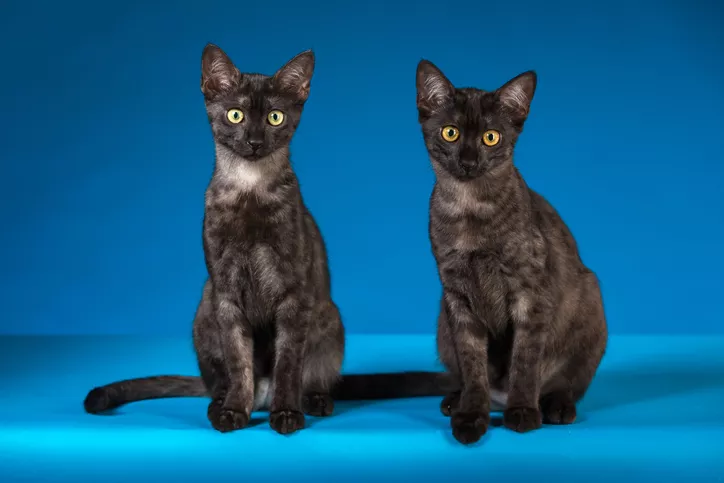- 01 of 05
Egyptian Mau
We have no written records of the Egyptian mau’s history, but it’s commonly accepted that the breed has ancient origins and developed from Egyptian street cats. Egyptian drawings show heavily spotted cats with the same mascara markings and barring pattern seen on the modern Egyptian mau. The breed is thought to have first appeared in the United States in 1956 when exiled Russian Princess Nathalie Troubetskoy brought her Egyptian mau cats with her.
Today, street cats in Egypt are often called Nile Valley Egyptian Cats and many of them resemble the Egyptian mau.
The Bengal cat breed is believed to have been developed through cross-breeding with the Egyptian mau.
Breed Overview
WEIGHT: 6 to 14 pounds
LENGTH: Up to 16 inches
PERSONALITY: Playful, active, devoted, loyal, alert, affectionate on their own terms
COAT LENGTH: Medium-length shorthair
COAT COLOR: Silver, bronze, or smoke with dark spots of varying sizes that occur only on the tips of the fur. Other characteristics include a dorsal stripe extending along the tail to a dark tail tip. The forehead has an “M” marking and the face has “mascara” lines that start at the corner of the eyes and sweep along the cheeks.
EYE COLOR: Green
LIFESPAN: 12 to 15 years
- 02 of 05
Chausie
The medium- to large-sized chausie (pronounced chow-see), is a hybrid breed created by crossbreeding domestic cats and a small wildcat species called the jungle cat that was revered by ancient Egyptians.
Although the chausie is a modern breed—created in the United States in the 1990s—their jungle cat heritage ties them directly to Egypt. Domestic cats used in the creation of the chausie include the Abyssinian and the domestic shorthair.
Breed Overview
Weight: About 15 to 25 pounds
Length: About 20 to 22 inches
Personality: Friendly, playful, active, affectionate
Coat Length: Short to medium, with a dense, soft undercoat and a somewhat resilient, slightly coarser outer coat
Coat Color: Brown ticked tabby, black grizzled ticked tabby or black
Eye Color: Any color, including blue or odd-eyed
Life Expectancy: 15 to 20 years
- 03 of 05
Abyssinian
The small, shorthaired Abyssinian is one of the oldest cat breeds. Perhaps due to the breed’s striking resemblance to the cats depicted in ancient Egyptian hieroglyphs, many sources identify the Abyssinian cat’s country of origin as Egypt or Ethiopia (formerly known as Abyssinia). However, the most recent genetic research suggests the coast of the Indian Ocean and parts of Southeast Asia as the most likely birthplace of the Abyssinian cat.
The breed name Abyssinian came about because, in the 1800s, some English fanciers imported cats matching the description of today’s Abyssinian and exhibited them at cat shows in England, stating that the cats were obtained from Abyssinia.
Breed Overview
WEIGHT: Up to 12 pounds
LENGTH: Up to 28 inches
PERSONALITY: Friendly, interactive, animated, active, and playful
COAT LENGTH: Short hair
COAT COLOR: Solid or ticked; ruddy, red, blue, cinnamon, or fawn
EYE COLOR: Green or gold
LIFESPAN: Up to 15 years
- 04 of 05
Savannah
With their spotted coat, the Savannah cat might look like cats in Egyptian art, but they were developed in the United States in the 1980s by crossing a small, African wildcat species called the serval with domestic cats. Like their serval relative, the Savannah cat is tall and slender with a long neck, large ears, and a gorgeous spotted coat. This breed needs more exercise and mental stimulation than most cats, so don't plan to bring one home unless you can give them the exercise and stimulation they need to be healthy and happy.
Breed Overview
WEIGHT: 12 to 25 pounds
LENGTH: 20 to 22 inches
PERSONALITY: Affectionate and social with owners, pets, and older children; intelligent and trainable
COAT LENGTH: Short to medium hair
COAT COLOR: Tawny, black/brown spotted tabby, black/silver spotted tabby, or black smoke with a solid or tabby pattern
EYE COLOR: Amber or green
LIFESPAN: Up to 20 years
Continue to 5 of 5 below - 05 of 05
Sphynx
Many people think that the Sphynx cat comes from Egypt due to their resemblance to ancient Egyptian depictions of cats. It’s also possible that people confuse the Sphnyx cat with the mythical sphinx—a creature with the head of a human, body of a lion, and wings of an eagle. Ancient Egyptians believed the sphinx could guard royalty, so they built many statues of the sphinx, including the most famous: the Great Sphinx of Giza.
Alas, the wrinkled, hairless Sphynx cat claims Canada, as their birthplace. Sphynx cats feel like warm suede or chamois because they are covered in a soft down. Sphynx don’t shed and need no brushing, but they must be bathed somewhat regularly to remove any buildup of skin oils and to keep their skin healthy.
Breed Overview
WEIGHT: Less than 12 pounds
LENGTH: 13 to 15 inches, head to tail
PERSONALITY: Playful, affectionate, friendly, energetic, and loving
COAT LENGTH: Nearly hairless, peach fuzz
COAT COLOR: Any color, including white, black, red, brown, white, and lilac
EYE COLOR: Any color
LIFESPAN: 8 to 14 years
More Cat Breeds and Further Research
To explore more cat breeds, check out:




















